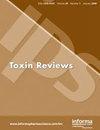药用植物苦参、黄叶翼木和白荆提取物对米象虫的植物化学成分、毒性和驱避作用。
IF 2.4
4区 医学
Q2 TOXICOLOGY
引用次数: 0
摘要
摘要米螟是储藏水稻的一种重要害虫,通常使用对人类有危害的磷化铝进行防治。植物杀虫剂被认为是控制这种害虫的有前景的替代品。在本研究中,对骆驼蓬种子、五叶Pterocarya fraxinifolia叶和白头翁花的提取物进行了抗米曲霉成虫的评价。植物化学分析表明,提取物中含有甾体、萜类、单宁、生物碱和类黄酮。生物测定显示,所有提取物都具有排斥作用,此外,骆驼蓬提取物具有显著的死亡率(93.33 ± 6.6%,LC50:521.06 mg/ml),因此它可用于防止米曲霉对储藏的水稻的侵扰。亮点本研究所研究的植物提取物能有效抵御水稻象甲。这些植物提取物对稻象甲具有显著的毒性。生物碱、类固醇、萜类、单宁和类黄酮存在于这些植物的提取物中。本文章由计算机程序翻译,如有差异,请以英文原文为准。
Phytochemical composition, toxicity, and repellent effects of medicinal plants Peganum harmala, Pterocarya fraxinifolia, and Tanacetum parthenium extracts against Sitophilus oryzae L.
Abstract Sitophilus oryzae is an important pest of stored rice and is usually controlled by the use of aluminum phosphide, which is dangerous to humans. Botanical insecticides deemed promising alternatives in controlling this pest. In this study, extracts of Peganum harmala seeds, Pterocarya fraxinifolia leaves, and Tanacetum parthenium flowers were evaluated against S. oryzae adults. Phytochemical analyses showed that steroid, terpenoid, tannin, alkaloid, and flavonoid are present in the extracts. Bioassays revealed repellency effects of all extracts, besides, P. harmala extract exerted significant mortality (93.33 ± 6.6%, LC50: 521.06 mg/ml) hence it may have applications in preventing infestation of stored rice by S. oryzae. Highlights Plant extracts studied in this research efficiently repel rice weevil. These plant extracts show significant toxicity against rice weevil. Alkaloid, steroid, terpenoid, tannin, and flavonoid are present in extracts of these plants.
求助全文
通过发布文献求助,成功后即可免费获取论文全文。
去求助
来源期刊

Toxin Reviews
医学-毒理学
CiteScore
6.80
自引率
0.00%
发文量
36
审稿时长
>12 weeks
期刊介绍:
Toxin Reviews provides an international forum for publishing state-of-the-art reviews and guest-edited single topic special issues covering the multidisciplinary research in the area of toxins derived from animals, plants and microorganisms. Our aim is to publish reviews that are of broad interest and importance to the toxinology as well as other life science communities. Toxin Reviews aims to encourage scientists to highlight the contribution of toxins as research tools in deciphering molecular and cellular mechanisms, and as prototypes of therapeutic agents. Reviews should emphasize the role of toxins in enhancing our fundamental understanding of life sciences, protein chemistry, structural biology, pharmacology, clinical toxinology and evolution. Prominence will be given to reviews that propose new ideas or approaches and further the knowledge of toxinology.
 求助内容:
求助内容: 应助结果提醒方式:
应助结果提醒方式:


